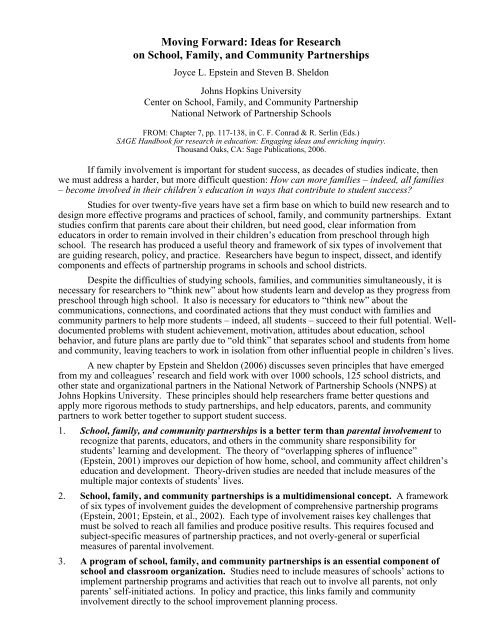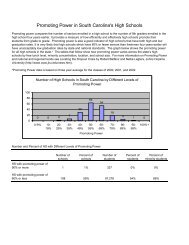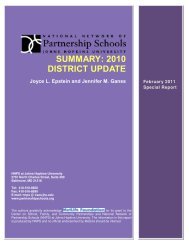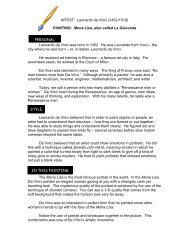Moving Forward: Ideas for Research on School, Family - National ...
Moving Forward: Ideas for Research on School, Family - National ...
Moving Forward: Ideas for Research on School, Family - National ...
You also want an ePaper? Increase the reach of your titles
YUMPU automatically turns print PDFs into web optimized ePapers that Google loves.
<str<strong>on</strong>g>Moving</str<strong>on</strong>g> <str<strong>on</strong>g>Forward</str<strong>on</strong>g>: <str<strong>on</strong>g>Ideas</str<strong>on</strong>g> <str<strong>on</strong>g>for</str<strong>on</strong>g> <str<strong>on</strong>g>Research</str<strong>on</strong>g><strong>on</strong> <strong>School</strong>, <strong>Family</strong>, and Community PartnershipsJoyce L. Epstein and Steven B. Sheld<strong>on</strong>Johns Hopkins UniversityCenter <strong>on</strong> <strong>School</strong>, <strong>Family</strong>, and Community PartnershipNati<strong>on</strong>al Network of Partnership <strong>School</strong>sFROM: Chapter 7, pp. 117-138, in C. F. C<strong>on</strong>rad & R. Serlin (Eds.)SAGE Handbook <str<strong>on</strong>g>for</str<strong>on</strong>g> research in educati<strong>on</strong>: Engaging ideas and enriching inquiry.Thousand Oaks, CA: Sage Publicati<strong>on</strong>s, 2006.If family involvement is important <str<strong>on</strong>g>for</str<strong>on</strong>g> student success, as decades of studies indicate, thenwe must address a harder, but more difficult questi<strong>on</strong>: How can more families – indeed, all families– become involved in their children’s educati<strong>on</strong> in ways that c<strong>on</strong>tribute to student success?Studies <str<strong>on</strong>g>for</str<strong>on</strong>g> over twenty-five years have set a firm base <strong>on</strong> which to build new research and todesign more effective programs and practices of school, family, and community partnerships. Extantstudies c<strong>on</strong>firm that parents care about their children, but need good, clear in<str<strong>on</strong>g>for</str<strong>on</strong>g>mati<strong>on</strong> fromeducators in order to remain involved in their children’s educati<strong>on</strong> from preschool through highschool. The research has produced a useful theory and framework of six types of involvement thatare guiding research, policy, and practice. <str<strong>on</strong>g>Research</str<strong>on</strong>g>ers have begun to inspect, dissect, and identifycomp<strong>on</strong>ents and effects of partnership programs in schools and school districts.Despite the difficulties of studying schools, families, and communities simultaneously, it isnecessary <str<strong>on</strong>g>for</str<strong>on</strong>g> researchers to “think new” about how students learn and develop as they progress frompreschool through high school. It also is necessary <str<strong>on</strong>g>for</str<strong>on</strong>g> educators to “think new” about thecommunicati<strong>on</strong>s, c<strong>on</strong>necti<strong>on</strong>s, and coordinated acti<strong>on</strong>s that they must c<strong>on</strong>duct with families andcommunity partners to help more students – indeed, all students – succeed to their full potential. Welldocumentedproblems with student achievement, motivati<strong>on</strong>, attitudes about educati<strong>on</strong>, schoolbehavior, and future plans are partly due to “old think” that separates school and students from homeand community, leaving teachers to work in isolati<strong>on</strong> from other influential people in children’s lives.A new chapter by Epstein and Sheld<strong>on</strong> (2006) discusses seven principles that have emergedfrom my and colleagues’ research and field work with over 1000 schools, 125 school districts, andother state and organizati<strong>on</strong>al partners in the Nati<strong>on</strong>al Network of Partnership <strong>School</strong>s (NNPS) atJohns Hopkins University. These principles should help researchers frame better questi<strong>on</strong>s andapply more rigorous methods to study partnerships, and help educators, parents, and communitypartners to work better together to support student success.1. <strong>School</strong>, family, and community partnerships is a better term than parental involvement torecognize that parents, educators, and others in the community share resp<strong>on</strong>sibility <str<strong>on</strong>g>for</str<strong>on</strong>g>students’ learning and development. The theory of “overlapping spheres of influence”(Epstein, 2001) improves our depicti<strong>on</strong> of how home, school, and community affect children’seducati<strong>on</strong> and development. Theory-driven studies are needed that include measures of themultiple major c<strong>on</strong>texts of students’ lives.2. <strong>School</strong>, family, and community partnerships is a multidimensi<strong>on</strong>al c<strong>on</strong>cept. A frameworkof six types of involvement guides the development of comprehensive partnership programs(Epstein, 2001; Epstein, et al., 2002). Each type of involvement raises key challenges thatmust be solved to reach all families and produce positive results. This requires focused andsubject-specific measures of partnership practices, and not overly-general or superficialmeasures of parental involvement.3. A program of school, family, and community partnerships is an essential comp<strong>on</strong>ent ofschool and classroom organizati<strong>on</strong>. Studies need to include measures of schools’ acti<strong>on</strong>s toimplement partnership programs and activities that reach out to involve all parents, not <strong>on</strong>lyparents’ self-initiated acti<strong>on</strong>s. In policy and practice, this links family and communityinvolvement directly to the school improvement planning process.
4. Programs of school, family, and community partnerships require multi-level leadership.Districts and states have leadership roles to play in guiding schools to strengthen and sustainprograms of family and community involvement (Epstein, in press; Sheld<strong>on</strong>, 2005, in press).<str<strong>on</strong>g>Research</str<strong>on</strong>g>ers can use methods of multi-level analyses, <str<strong>on</strong>g>for</str<strong>on</strong>g> example, to study the independentc<strong>on</strong>tributi<strong>on</strong>s and c<strong>on</strong>necti<strong>on</strong>s of district leaders’ support and schools’ acti<strong>on</strong>s to develop theirpartnership programs.5. Programs of school, family, and community partnerships must include a focus <strong>on</strong>increasing student learning and development. When plans <str<strong>on</strong>g>for</str<strong>on</strong>g> partnerships are linked toschool goals <str<strong>on</strong>g>for</str<strong>on</strong>g> student success, family and community involvement can measurably affectstudents’ learning and development (Epstein, 2001, Sheld<strong>on</strong>, 2003). This requires measuresthat assess the quality of program implementati<strong>on</strong>, interim outcomes (e.g., parents’ resp<strong>on</strong>ses),and ultimate outcomes of student achievement, attendance, behavior, health, and otherindicators of success. <strong>School</strong>s want students to develop academically, socially, emoti<strong>on</strong>ally,and physically at each age and grade level; families and communities can help students attainthese healthy outcomes.6. All programs of school, family, and community partnerships are about equity.7. Methods of research <strong>on</strong> school, family, and community partnerships must c<strong>on</strong>tinue to improve.This includes l<strong>on</strong>gitudinal data that accounts <str<strong>on</strong>g>for</str<strong>on</strong>g> schools and students’ “starting points,”matching samples <str<strong>on</strong>g>for</str<strong>on</strong>g> comparative analyses, path analyses, and multi-level analyses tounderstand influences <strong>on</strong> more equitable outreach and involvement. It is important <str<strong>on</strong>g>for</str<strong>on</strong>g> newstudies to attack particularly challenging measurement issues such as isolating the effects ofpartnerships <strong>on</strong> student outcomes from other simultaneously occurring school improvementsand explaining initially negative associati<strong>on</strong>s of some kinds of parental involvement with lowstudent achievement and poor behavior that are undertaken to help resolve those veryproblems.The sixth principle – equity – is pivotal <str<strong>on</strong>g>for</str<strong>on</strong>g> learning how to develop and sustain partnershipprograms that provide more equal opportunities <str<strong>on</strong>g>for</str<strong>on</strong>g> all families to become involved in ways thatsupport all students’ progress and success in school. It is imperative <str<strong>on</strong>g>for</str<strong>on</strong>g> researchers to design studiesthat go bey<strong>on</strong>d documenting inequities to identify programs and practices that promote greaterequity in the involvement of diverse families and greater equality of effects <str<strong>on</strong>g>for</str<strong>on</strong>g> students. It is alsoimperative <str<strong>on</strong>g>for</str<strong>on</strong>g> educators to know that programs of family and community involvement can beplanned, implemented, evaluated, and improved from year to year.All seven principles must guide new research and programs of school, family, andcommunity partnerships at the preschool, elementary, middle, and high school levels. By thinking innew ways about school, family, and community partnerships, researchers will c<strong>on</strong>tinue to increaseknowledge about partnerships and educators will improve policy and practice.Selected References. See the full chapter in the SAGE Handbook <str<strong>on</strong>g>for</str<strong>on</strong>g> a complete list of over 100references by many researchers <strong>on</strong> school, family, and community partnerships.Epstein, J. L. (2001). <strong>School</strong>, family, and community partnerships: Preparing educators and improving schools.Boulder, CO: Westview Press.Epstein, J. L. (in press). <str<strong>on</strong>g>Research</str<strong>on</strong>g> meets policy and practice: How are school districts addressing NCLBrequirements <str<strong>on</strong>g>for</str<strong>on</strong>g> parental involvement? In A. Sadovnik, J. O’ Day, G. Bohrnstedt, and K. Borman (Eds.). NoChild Left Behind and reducing the achievement gap: Sociological perspectives <strong>on</strong> federal educati<strong>on</strong>al policy.NY: Routledge.Epstein, J. L., Sanders, M. G., Sim<strong>on</strong>, B. S., Salinas, K. C., Jansorn, N. R., & Van Voorhis, F. L., (2002). <strong>School</strong>,family, and community partnerships: Your handbook <str<strong>on</strong>g>for</str<strong>on</strong>g> acti<strong>on</strong>, sec<strong>on</strong>d editi<strong>on</strong>. Thousand Oaks, CA: Corwin.Sheld<strong>on</strong>, S. B. (2003). Linking school-family-community partnerships in urban elementary schools to studentachievement <strong>on</strong> state tests. Urban Review, 35(2), 149-165.Sheld<strong>on</strong>, S. B. (2005). Testing a structural equati<strong>on</strong>s model of partnership program implementati<strong>on</strong> and familyinvolvement. The Elementary <strong>School</strong> Journal. 106, 171-187.Sheld<strong>on</strong>, S. B. (in press). Getting families involved with NCLB: Factors affecting schools’ enactment of federalpolicy. In A. R. Sadovnik, J. O’ Day, G. Bohrnstedt, and K. Borman (Eds.). No Child Left Behind and reducingthe achievement gap: Sociological perspectives <strong>on</strong> federal educati<strong>on</strong>al policy. NY: Routledge.2






